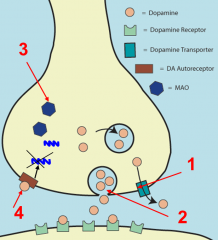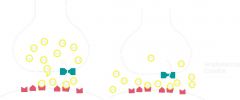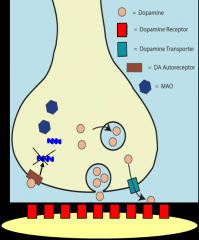![]()
![]()
![]()
Use LEFT and RIGHT arrow keys to navigate between flashcards;
Use UP and DOWN arrow keys to flip the card;
H to show hint;
A reads text to speech;
30 Cards in this Set
- Front
- Back

Amphetamine: How it effects neurotransmission
|
1. Blocks re-uptake of DA and NEpi
2. Causes release of DA and NE pi - 3. Mild Inhibition of MAO 4. Tolerance is due to depletion of catelcholamines, primarily by reduced synthesis due to increased autoreceptor activity |
|

Amphetamine/cocaine tolerance
|
depletion of neurotransmitter so that additional administration of the drug produces less effects
|
|

Sensitization to cocaine
|
-Chronic use depletes DA
-In response to depleted DA, neurons compensate by UPREGULATING, receptor numbers and INCREASING SENSITIVITY -Effect of cocaine is enhanced because of number of receptors |
|
|
Pharmacodynamics of caffeine
|
-Adenosine receptor ANTAGONIST
-Adenosine normally slows down neural activity -Relief of inhibition increases neuronal activity -Therefore, blocking adenosine receptors increases neural activity -Caffeine is AGONIST of transmitter release |
|
|
Mechanisms of action: caffeine
|
-GABA is inihibotory
-GABA receptor ANTAGONIST -Blocking GABA receptors reduces inhibition in the brain, and leads to overall arousal. |
|
|
Pharmacodynamic tolerance of caffeine
|
Due to UP-REGULATION of ADENOSINE receptors as the brain tries to deal with continued suppression of adenosine activity
|
|
|
Pharmacodynamics of Nicotine
|
-Acts as AGONIST at nicotine acetylcholine receptor
-Stimulates the receptor, then blocks it via inactivation |
|
|
Alcohol's effect on receptors
|
-Enhances activity of GAPA receptor: hyperpolarizes neuron by allowing Cl- to enter
-Decreases the activity of some glutamate receptors: inhibits excitatory effects at the NMDA receptor by blocking the ion channel pore decreasing the amount of Na and Ca ion entry -Net result is to decrease excitability of neurons, and reduce spontaneous firing |
|
|
CNS (physiological effects) of alcohol
|
-Mechanism for apparent stimulation is thought to be inhibition of inhibitory neurotransmission
- Loss of inhibitory control in RAS and cortex which are normally used for mental functions -Inihibition in RAS and Cortex results in a decrease of self-control 1. Reduces release of inhibitory neurotransmission 2. Reduces firing of inhibitory pathways 3. Decreases excitatory neurotransmission |
|
|
tolerance of alcohol
|
-Mechanism: induction of liver enzymes
-Decreased neurotransmission may lead to upregulation and sensitization of postsynaptic receptors -Upregulation of NMDA receptors important to with drawal. -Little tolerance to lethal effects |
|
|
Alcohol: Dependence and Withdrawal
|
-Both physical AND psychological dependence
-Reinforcing properties due to stimulation of 5-HT3 receptor (important step for releasing DA into the NA) |
|
|
Pharmacodynamic tolerance
|
-Drugs that amplify or mimic the actions of a neurotransmitter tends to DECREASE receptor activity.
****Down-regulation:decrease in number of functional receptors ****Desentization: decrease in receptor's ability to elicit changes -Drugs that act as antagonists of tend to INCREASE receptor activity |
|
|
Cannabis Pharmacodynamics
|
-effects can be both excitatoy and inhibitory
|
|
|
Cannabis mechanism of action
|
-Binds to CB1 and CB2 Receptors - localize to hippocampus, cerebral cortex, amygdala
-All canabanoid receptors are METABOTROPIC -Meteabotropic receptors are linked to G-Proteins -DECREASE neurotransmission release -inhibit acetylcholine release in hippo, inhibit NE release |
|
|
Cannabis receptors in the brain
|
Few to no cannabanoid receptors in the VTA, however it does activate central reward pathways, leading to release of DA in NA.
-Therefore marijuana's effect on reward pathway is indirect -THC decreases GABA inhibition of VTA, therefore DA in NA |
|
|
Cannabis tolerance
|
Primarily due to desensitization/down-regulation of cannabanoid receptors (because cannabanoid receptors are agonists)
|
|
|
LSD effects at cellular level
|
-Serotonin receptor AGONIST
-Agonist of 5HT-2 receptors (post-synaptic) -Actively altered in RAS: No longer filters sensory info. |
|
|
PCP cellular effects
|
-Acts as channel blocker for a subtype of glutamate receptor
-Ionotropic NMDA receptor: Precents CA+ and Na+ from flowing into neuron -Prevents DA re-uptake |
|
|
MDMA (ecstasy) cellular effects
|
-Destroy monoamine (DA, NE, and Seratonin) neurons
-Decrease in brain's serantonin transporter |
|
|
Heroin effects
|
- Opiates bind to endogenous opioid receptors to produce INIHIBITION
-Increases DA in the NA -Heroin converted to morphine in the brain which acts at the mu and delta receptors expressed on inihibitory GABA neurons. -The binding of mu and delta at GABA causes REDUCTION in amount of GABA released. This inhibition leads to increases of DA in NA |
|
|
Heroin tolerance
|
desensitization/down-regulation
|
|
|
Tricyclic Anti-depressants vs SSRI
|
TCAs: block re-uptake of NE and 5-ht, thereby increasing synaptic levels
SSRI: SELECTIVELY blocks 5-ht re-uptake rather than both |
|
|
Monoamine theory of depression
|
Monoamines are low in depressed people.
If this is the case, what would you expect to see in the brains of patients: UPREGULATION of 5ht and NE receptors |
|
|
Kluver-Buchy Syndrome (anxiety)
|
Reduction of fear after BILATERAL AMYGDALA DAMAGE
|
|
|
HPA (Anxiety)
|
-Very important in stress
-Boosts cortisol and activates it |
|
|
Factors implicated in medication of Anxiety disorders
|
Central: NE, 5HT, GABA
Peripheral: Release of ACTH, adrenal cortisol, and NE Increased NE firing in Locus Ceruleus Increased sensitivity in amygdala HPA activation |
|
|
Barbituates - Pharmacodynamics
|
-Barbituates enhance GABA receptor activity
-Noncompetitve Agonist -Results in opening of Cl- Channel -Results in hyperpolarization of neuron, less excitable |
|
|
Benzos
|
Decreases excitatory neuronal activity in cortex, RAS, limbic system
Difference: seems to decrease hypothalamus activity Enhance activity of endongenous GABA INDIRECT GABA AGONISTS |
|
|
Difference between Benzos and Barbituates
|
Barbs - Absorbed rapidly, low TI, REM sleep
Benzos - Absorbed slowly, longer duration of action, higher TI, less effects on REM sleep |
|
|
Anti-psychotic treatment
|
Primary dopamine receptor ANTAGONISTS
|

